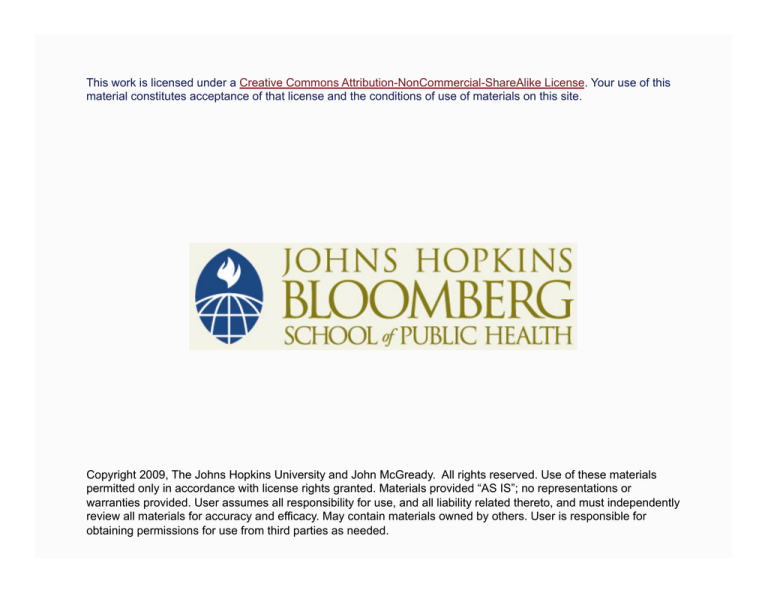
This work is licensed under a Creative Commons Attribution-NonCommercial-ShareAlike License. Your use of this
material constitutes acceptance of that license and the conditions of use of materials on this site.
Copyright 2009, The Johns Hopkins University and John McGready. All rights reserved. Use of these materials
permitted only in accordance with license rights granted. Materials provided “AS IS”; no representations or
warranties provided. User assumes all responsibility for use, and all liability related thereto, and must independently
review all materials for accuracy and efficacy. May contain materials owned by others. User is responsible for
obtaining permissions for use from third parties as needed.
Multivariate Survival Analysis
John McGready
Johns Hopkins University
Example
“Impact of socioeconomic status on survival with AIDS”
American Journal of Epidemiology,
Volume 148, No. 3 (1998)
3
Methods
Statistics
Median length of survival and cumulative
probability of survival after an AIDS diagnosis were
calculated using the Kaplan-Meier product limit
method
Differences in survival period according to
socioeconomic status were analyzed using logrank
Continued
4
Methods
Statistics
Proportional hazards (Cox) regression was used to
assess the association between survival and
socioeconomic status after adjustment for
potential intervening variables
All covariates were entered simultaneously into the
multivariable model
5
Results
Continued
6
Results
Continued
7
Results
8
Example: Cox Proportional Hazards Model
“Donation of blood is associated with risk of myocardial
infarction”
American Journal of Epidemiology, Volume 148,
No. 5, 1998
9
Blood Donation Example
“Because high body iron stores have been suggested as a
risk factor for acute myocardial infarction, a donation of
blood could theoretically reduce the risk by lowering
blood iron stores . . .”
Continued
10
Blood Donation Example
“A cohort of 2,862 men aged 42–60 years were followed
for an average of almost nine years”
“One man (0.7%) out of 153 men who had donated
blood in 24 months preceding the baseline examination
experienced an acute myocardial infarction during 1984–
1985. . . .”
Continued
11
Blood Donation Example
“. . . whereas 316 men (12.5%) of 2,529 non-blood donors
had an acute myocardial infarction (p < .0001 for
difference in proportions)”
12
Results
Continued
13
Results
14
Conclusions
“These results indicate that frequent blood loss through
voluntary blood donation may be associated with
reduced risk of acute MI in middle-aged men”
15
Issues in Interpreting Results
This was an observational study NOT a randomized trial
Seems likely that blood donors are different than nondonors
Continued
16
Issues in Interpreting Results
Can we be sure we adjusted for all covariates?
17
Smoking and Asthma
“Predictors of cigarette smoking and smoking cessation
among adults with asthma”
American Journal of Public Health, Volume 90,
No. 48, 2000
Continued
18
Smoking and Asthma
“Remarkably, up to half of U.S. adults with asthma have
regularly smoked cigarettes”
“Despite this high lifetime prevalence, the factors
predisposing asthmatic persons to initiate smoking are
not well understood”
Continued
19
Smoking and Asthma
“Furthermore, the predictors of smoking cessation,
which is a clear priority in adults with asthma, have not
been previously examined”
20
Methods
“In the stratum of ever smoking subjects, we constructed
a Kaplan-Meier curve to illustrate time until smoking
cessation”
“We use Cox PH regression to determine the
independent predictors of time until smoking cessation”
21
Subject Characteristics Table, Part 1
22
Subject Characteristics Table, Part 2
Continued
23
Subject Characteristics Table, Part 2
24
Results
“In comparison with college or graduate-level
attainment, completion of less than 12th grade was
related to a longer period until smoking cessation”
“Age at smoking initiation also predicted smoking
cessation, with younger initiation (13 years or younger)
associated with longer time until cessation”
Continued
25
Results
“These confidence intervals, however, did not exclude
the possibility of no effect”
“Daily cigarette consumption of more than one-half pack
was also related to a longer period until smoking
cessation”
“Conversely, in comparison with early childhood onset of
asthma symptoms, onset in late childhood or
adolescence was associated with more rapid quitting”
26
Conclusions
“Because cigarette smoking is common in people with
asthma, smoking prevention and cessation should be
priorities in clinical asthma care”
“Asthmatic adults with early childhood asthma onset,
early smoking initiation, or heavy daily cigarette
consumption may require intensive smoking cessation
interventions”
27
Evaluation
Your feedback on this lecture
presentation is very important and will
be used for future revisions. Please
take a moment to evaluate this lecture.
The Evaluation link is available on the
lecture page.
28





